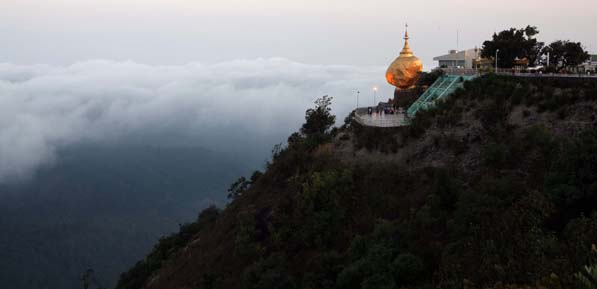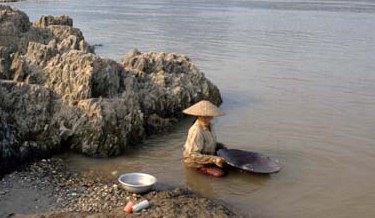River of Gold

The waters of the Irrawaddy yield more than just fish
The Irrawaddy River is the lifeblood of Burma, providing livelihoods for the communities that live on its banks. In the monsoon the river irrigates their farmland—while in the dry season it yields gold.
The people of the Irrawaddy have been panning for gold for centuries, passing down from one generation to another the skills needed to extract the precious metal from the river’s sand and silt.
 |
The mixture is strained through a cloth and then heated to allow the noxious mercury to evaporate, leaving behind small nuggets of gold.
Middlemen buy the gold and sell it to craftsmen, mostly in Mandalay—a city where virtually every pagoda is covered in gold.
In Mandalay’s Myetpayat quarter, about 50 workshops specialize in producing the gold leaf that worshipers and pilgrims apply to pagodas and Buddha images. In the past, Burma’s rulers donated huge quantities of gold to adorn sacred pagodas—the 15th century Mon queen Shin Sawbu delivered to one temple her own weight in gold, while Rangoon’s iconic Shwedagon pagoda is clothed in 141 kilograms of the precious metal.
Because most of the Irrawaddy gold ends up on Buddha images and pagodas, the craftsmen traditionally believe that their work earns them the merit that will help them advance toward Nirvana.
It’s certainly hard labor, hammering out the wafer-thin leaves. It takes one ounce (28.35 g) of gold to produce a 10 square meter leaf just over one thousandth of a millimeter thick.
The leaves of gold are then divided into packets of 100, each separated by thin bamboo paper and then wrapped in buckskin. The women who perform this work have marble dust on their fingers to prevent the wisps of gold sticking to them.
The flimsy pieces of gold don’t only end up on Buddha images or pagodas. Millions of them adorn one of Burma’s most astonishing sights, the “Golden Rock of Kyaiktiyo” in Karen State.
The gilded rock teeters precariously at the edge of a cliff on Kyaiktyo mountain. Local lore says the rock stands on a strand of the Buddha’s hair, drawing crowds of pilgrims who stick their tiny offerings of gold on the rough stone surface.
Photojournalist Patrick Blanche traveled the gold route from the Irrawaddy River to Kyaiktiyo mountain, via the goldsmiths of Mandalay, and put together this pictorial record of his journey.
